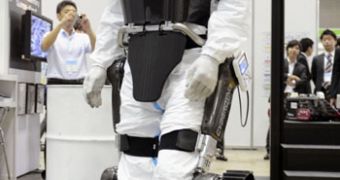The nuclear meltdown that occurred at the Fukushima power plant last year (March 11, 2011) left behind a zone thick with radiation, one that has yet to be cleared despite ongoing efforts to repair the situation. Cyberdyne is finally ready to help at least.
Cyberdyne is basically doing the opposite of what NASA is thinking of doing to the exoskeleton initially meant to take man to the hostile regions of space.
Whereas the latter is turning a special-purpose exoskeleton into something that can help disabled people walk, the former is transforming a power suit for physiotherapy into something capable of taking man into hostile environments, albeit of a different sort.
The HAL (Hybrid Assistive Limb, not the HAL 9000 computer from Space Odyssey) has been lined with tungsten shielding, which can cut radiation exposure in half, according to University of Tsukuba professor Yoshiyuki Sankai.
One might say it is a bit too late after a year and a half, but Japan still has a number of nuclear plants, as well as some that are still under construction. If, fate forbid, some disaster hits them too somehow, a repeat of Fukushima can be averted.
For those that need to be put up to speed with what exactly happened that left Fkushima a nuclear dead zone, an earthquake and tsunami are to blame.
Measuring 9.03 on the moment magnitude scale, the quake was centered off the coast of Japan and, aided by the large tsunami it caused, damaged or outright destroyed four of the six reactors. The remaining two were subsequently shut down.
In addition to protecting wearers from the radiation still flooding the place, HAL will increase their strength by responding to user movements based on electrical impulses in the skin. This was a feature that Cyberdyne always planned to implement, even before repurposing HAL for hazard control.
The wearer's heart rate and temperatures are monitored as well, while heatstroke is averted thanks to an exhaust fan.

 14 DAY TRIAL //
14 DAY TRIAL //